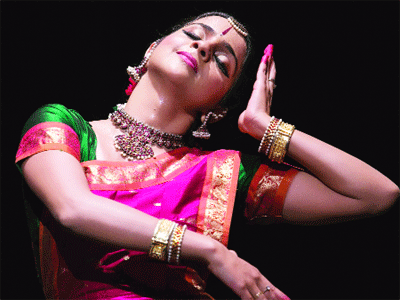UK Banerjee watches a performance by students of Saroja Vaidyanathan, who seemed to shoulder tradition rather confidently
Post-independence, India saw its classical dances undergo what some perceptive critics call a “renaissance.” In the process, gurus emerged, who resurrected the grammar and cannon of various genres and groomed a bevy of disciples to perform according to the given credo. In the ensuing seven decades, while more and more trained performers have come up, there has been a flip side too. With the disappearance of temples and the royalty as erstwhile patrons, natya mandapas (temple-arenas) and court gardens have totally vanished, without commensurate performance space being added for public viewing.
The net result is that while senior performers manage to get their audience in the available halls, there is an acute dearth of platforms for young learners to display their acquired skill. The HCl Concert Series at IHC, providing succour to the Gen-X of dancers and musicians over the last 17 years, has been a welcome step in this direction. Its hallmark has been to nurture intellectually-strong dancers, vocalists and instrumentalists and provide them with a paid platform for performance. In a recent Bharatanatyam presentation, for instance, the series featured as many as three performers — one female and two male — sharing the proscenium stage.
Another praiseworthy feature was that the gurus, Saroja Vaidynathan and Rama Vaidyanathan, facilitated their departure from the conventional margam (standard sequence of items) and allowed them to navigate other shores connected with a galaxy of divinities like Shakti, Vishnu, Shiva, Krishna and Kartikeya.
The main danseuse Nehha Bhatnagar — with some eight years of grooming to sustain her — seemed have taken to her mentor Rama whole-heartedly. Her opening Devi stuti, on a garland of ragas: Gowlai, Suruthi and Hamsanandi, was a most vigorous recapitulation of the mighty goddess Shakti as a destroyer of all evils and provider of liberation and bliss to her devotees. With ample sancharis (gaits), utplabanas (leaps) and bhramaris (turn-arounds), she set the stage ablaze, occasionally with extra abandon that needed to be tamed.
Her next composition by Maharaja Swati Thirunal, Pannagendra Shayanam, dedicated to Padmanabha Swamy, was far more subdued as well as more elegantly carved. The lord — reclining on the primordial snake Adi Shesha in the ocean of milk; having lotus-petal eyes, pearly white teeth and majestic gait of an elephant; and exuding every fragrance on earth and heaven — was aesthetically more satisfying, evocative of the lovelornnayika (heroine) — longing to be grasped in his four arms.
The third item, Ta tai En Aadvar, in praise of the dancing lord Nataraja in the golden kutumbalam (precinct) of Chidambaram temple — by the male-duo Amrit Sinha and Himanshu Srivastava — was the right choice of composition for visualising Shiva tandava (virile dance). The duo alternated with lifting their left feet up and doing salutation to that kunchitapada (specific posture). Composed by Gopalakrishna Bharati in the soothing raga Sindhu Bhairavi (same as the north Indian Bhairavi), the choreography came through very well with swaying actions making the entire universe seemingly tremble.
This was followed by a Meera Bhajan, a composition around Giridharilal by that 16th century mystic poet, in raga Yeminii Kalyani (akin to north India’s Yaman). The serene similes ran: “If I were a fish, I would caress his feet/ If I were a cuckoo, I would sing to him while he bathed in a stream/ If I were a pearl, I would weave myself into a necklace for him.” The north Indian audience savoured every syllable of the song and enjoyed every move of Nehha’s accompanying dance.
The finale was a grand pas de trio around a fast-paced Tillana, eulogising Murugan (Kartikeya). Alternately, the three dancers were the lord, the peacock or the devotee, bestowing blessings of knowledge and grace on one and all. The resonance in ragaBehag concluded with a lilting first stanza of Bankim Chandra’s Vande Mataram. The leitmotif of the evening was provided by guru Saroja Vaidyanathan, “When youngsters dance, it is not always wise to load them with a complex varnam, although that appears to be the customary approach in the south. Instead, I’ve tried to give them a mix of compositions around traditional deities but not a full margam with a varnam thrown in. I also think the mix of well-trained youthful dancers — from both genders — makes for a good evening’s fare.”


























